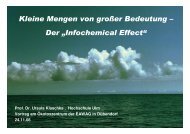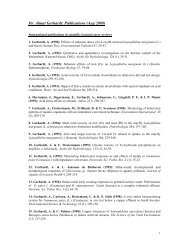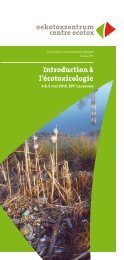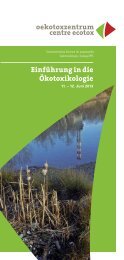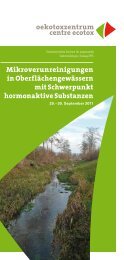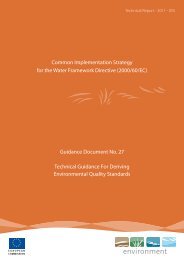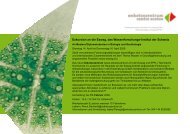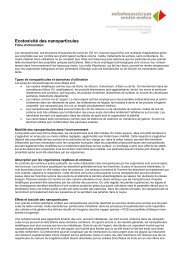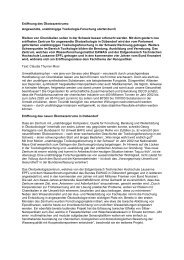Evaluation of Bioassays and Wastewater Quality ... - Oekotoxzentrum
Evaluation of Bioassays and Wastewater Quality ... - Oekotoxzentrum
Evaluation of Bioassays and Wastewater Quality ... - Oekotoxzentrum
You also want an ePaper? Increase the reach of your titles
YUMPU automatically turns print PDFs into web optimized ePapers that Google loves.
3. Approach<br />
3.1. <strong>Bioassays</strong><br />
A broad range <strong>of</strong> biotests for the evaluation <strong>of</strong> water <strong>and</strong> wastewater quality is available. An<br />
important goal <strong>of</strong> this project was to identify appropriate bioassays sensitive enough to detect the<br />
effects <strong>of</strong> micropollutants. The selection <strong>of</strong> ecotoxicological test systems was based on<br />
preliminary studies conducted before the first pilot study at the WWTP Wüeri Regensdorf, <strong>and</strong> on<br />
surveys performed during the Regensdorf pilot study with 17 bioassays, including tests for<br />
measuring specific cellular effects, as well as integrative tests with whole organisms (Abegglen et<br />
al., 2009). Based on the results <strong>of</strong> these studies, <strong>and</strong> on the input from an international expert<br />
group on ecotoxicology, the most suitable tests as well as several additional mechanism-oriented<br />
in vitro assays were chosen for the Lausanne pilot study. A set <strong>of</strong> 16 in vitro <strong>and</strong> 9 in vivo<br />
bioassays was selected based on one or more <strong>of</strong> the following selection criteria (Abegglen et al.,<br />
2009):<br />
� Test sensitivity is high enough to detect contaminant effects in treated wastewater<br />
(WWTP effluent) in the preliminary studies<br />
� St<strong>and</strong>ardised test methods are available (OECD-, DIN or ISO certification)<br />
� Consideration <strong>of</strong> different trophic levels (bacteria, algae, macrophytes, invertebrates,<br />
vertebrates)<br />
� Application <strong>of</strong> different types <strong>of</strong> sample processing <strong>and</strong> test systems:<br />
a) assessment <strong>of</strong> enriched wastewater samples<br />
b) assessment <strong>of</strong> wastewater samples without sample enrichment<br />
c) effect measurements with organisms in flow-through systems (channels,<br />
microcosms)<br />
Two types <strong>of</strong> bioassays were used:<br />
� In vitro bioassays based on specific cellular mechanisms measure cellular effects specific<br />
to groups <strong>of</strong> toxicants with similar modes <strong>of</strong> action. These assays use cell cultures or<br />
transgenic bacteria or yeast to detect changes in receptor activation or enzyme function,<br />
e.g. endocrine, genotoxic or mutagenic effects; or inhibition <strong>of</strong> signal transduction.<br />
� For a better evaluation <strong>of</strong> integrative effects on whole organisms, validated <strong>and</strong><br />
st<strong>and</strong>ardised in vivo assays with test species from different trophic levels (algae,<br />
macrophytes, invertebrates <strong>and</strong> fish) are applied. These assays measure effects on<br />
parameters such as growth, reproduction, feeding activity <strong>and</strong> mortality, as well as effects<br />
based on more specific biochemical endpoints, e.g. vitellogenin concentration in the fish<br />
early life stage assay.<br />
In this report, the following assays were referred to as in vitro bioassays based on the specific<br />
endpoints measured: Ames, micronucleus <strong>and</strong> umuC assay, YES <strong>and</strong> CALUX assays, H295R<br />
assay <strong>and</strong> combined algae assay, similar to Ratte <strong>and</strong> Ratte (2009). The term in vivo bioassays<br />
was used for assays with bacteria, algae, duckweed, aquatic crustaceans, oligochaetes, snails<br />
<strong>and</strong> fish.<br />
Swiss Centre for Applied Ecotoxicology, Eawag/EPFL · Überl<strong>and</strong>strasse 133 · CH-8600 Dübendorf<br />
www.oekotoxzentrum.ch<br />
6



